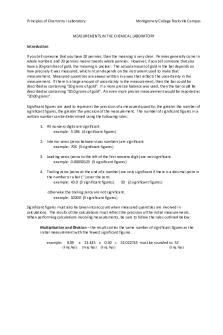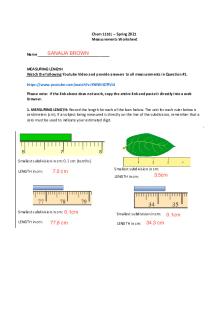CHE111 Laboratory Techniquesand Measurements 100389 PDF

| Title | CHE111 Laboratory Techniquesand Measurements 100389 |
|---|---|
| Course | General Chemistry Lab I |
| Institution | University of Kentucky |
| Pages | 13 |
| File Size | 618.9 KB |
| File Type | |
| Total Downloads | 60 |
| Total Views | 149 |
Summary
part of lab manual...
Description
CHE 111 Laboratory Techniques and Measurements Final Report Student Name
Rachel Hibbard
Student ID
100389
Lesson
Laboratory Techniques and Measurements
Institution
University of Kentucky
Session
Summer 2020
Course
CHE 111
Instructor
April French
Test Your Knowledge 1. Rank the measurements in order from smallestto largest. 3.0 x 10 -7 m 2.0 x 10 -6 m 1.0 x10 -5 m 1.0 m 4.0 x 10 3 mm
2. Match each SI base unit to the appropriate measurement.
Length
Mass
Time
Temperature
Amount of Matter
1
2
3
4
5
meter
kilogram
second
kelvin
mol
Copyright 2021 - Science Interactive | https://scienceinteractive.com
3. Perform the following conversions.
345.7 K
Convert 61°F to °C
1
16° C
12° C
Convert 19.4° C to K
2
292.6 K
Convert 15.3 mm to cm
3
1.53 cm
Convert 4.25 cm to m
4
0.0425 m
Convert 218.4 g to kg
5
0.2184 kg
2.53 cm 0.425 m 2.184 kg
Exploration 1. A micrometer is equal to 0.000001 m. True False
2. The SI system is derived from the _____. United States system metric system English unit system math system
3. Every measuring device measures length to the same degree of accuracy and precision. True False
Copyright 2021 - Science Interactive | https://scienceinteractive.com
4. The SI systemunit fortemperature is _____. degreesCelsius degreesFahrenheit kelvin
5. One liter is equal to _____. 1cm3 10cm3 100cm3 1,000cm3
6. A meniscus is the curve that forms between the liquid and the surface of the container. True False
7. Graduated cylinders and graduated pipets are designed to measure _____ volume(s). a range of only one
8. Archimedes’ method is used to measure the volume of a(n) _____. square rectangle irregularly shaped object
Copyright 2021 - Science Interactive | https://scienceinteractive.com
8. Archimedes’ method is used to measure the volume of a(n) _____. square rectangle irregularly shaped object
10. In the equation C1 x V1 = C2 x V2 , C1 represents the _____ of the solution. initial concentration initial volume final concentration final volume
11. The final digit in any measurement is the estimated, uncertain digit. True False
Exercise 1 1. Water boils at 100°C at sea level. If the water in this experiment did not boil at 100°C, what could be the reason? If the water in this experiment did not boil at 100 degrees Celsius, that could indicate that the location of the experiment was not at sea level
2. While heating two different samples of water at sea level, one boils at 102°C and one boils at 99.2°C. Calculate the percent error for each sample from the theoretical 100.0°C. The percent error for 102 would be a 2% error and the one that boils at 99.2 would be a 0.8% error
Data Table 1: Length Measurements
Copyright 2021 - Science Interactive | https://scienceinteractive.com
Length (cm)
Length (mm)
Length (m)
CD or DVD
11.82
118.2
0.1182
Key
6.49
64.9
0.0649
Spoon
16.26
162.6
0.1626
Fork
19.85
198.5
0.1985
Data Table 2: Temperature Measurements
Temperature (°C)
Temperature (°F)
Temperature (K)
Hot from Tap
46.1
114.98
319.25
Boiling
93.8
200.84
366.95
Boiling for 5 minutes
94.9
202.82
368.05
Cold from Tap
25.1
77.18
298.25
Ice Water - 1 minute
11.0
51.8
284.15
Ice Water - 5 minutes
9.5
49.1
282.65
Data Table 3: Mass Measurements
Copyright 2021 - Science Interactive | https://scienceinteractive.com
Estimated Mass (g)
Actual Mass (g)
Actual Mass (kg)
Pen or Pencil
8.0
8.57
0.00857
3 Pennies
7.5
8.05
0.00805
1 Quarter
7.0
5.75
0.00575
2 Quarters, 3 Dimes
26.0
18.26
0.01826
4 Dimes, 5 Pennies
28.5
22.20
0.02220
3 Quarters, 1 Dime, 5 Pennies
37.5
32.42
0.03242
Key
20.0
15.07
0.01507
Key, 1 Quarter, 4 Pennies
37.0
30.77
0.03077
Exercise 2 1. An unknown, rectangular substance measures 3.60 cm high, 4.21 cm long, and 1.17 cm wide. If the mass is 21.3 g, what is this substance’s density (in grams per milliliter)? The density is 1.2 g/mL
2. A sample of gold (Au) has a mass of 26.15 g. Given that the theoretical density is 19.30 g/mL, what is the volume of the gold sample? The volume is 1.35 mL.
Copyright 2021 - Science Interactive | https://scienceinteractive.com
3. A student was given an unknown metal. The studentdetermined that the mass of the metal was 30.2 g. The studentplaced the metal in a graduated cylinder filled with 20.0 mL of water. The metal increased the volume of water to 22.9mL. Calculate the density of the metal and determine the identity of the metal using the table below.
The density of the material is 10.41 g/mL, so it is most likely silver
Data Table 4: Liquid Measurements
Water
Isopropyl Alcohol
Mass A: Graduated Cylinder (g)
17.24
17.24
Volume (mL)
5.0
5.0
Mass B: Graduated Cylinder with Liquid (g)
22.10
21.64
Mass B-A: Liquid (g)
4.86
4.40
Density (g/mL)
0.972
0.88
Percent Error (%)
2.8%
12%
Data Table 5: Magnet - Direct Measurement Method
Copyright 2021 - Science Interactive | https://scienceinteractive.com
Magnet
Mass (g)
4.40
Length (cm)
2.51
Width (cm)
0.51
Height (cm)
0.51
Volume (cm3)
0.65
Density (g/cm 3)
6.77
Data Table 6: Water Displacement Method
Magnet
Metal Bolt
Mass (g)
4.40
7.50
Initial Volume of Graduated Cylinder (mL)
24.99
25.03
Final Volume of Graduated Cylinder (mL)
29.24
31.75
Object Volume (mL)
4.25
6.72
Density (g/mL)
1.04
1.12
Exercise 3 1. How would you prepare 10 mL of a 0.25% m/vHCl solution if 1% m/vHCl was available? How much 1% m/vHCl is needed? How much distilled water is used? You'd add 2.5 mL of 1% HCl and 7.5 mL of distilled water
Copyright 2021 - Science Interactive | https://scienceinteractive.com
2. From the graph of Density vs. Concentration, created in Graph 1, what was the relationship between the concentration of the sugar solution and the density of the sugar solution? The relationship between the two is linear
Data Table 8: Initial Concentration
Sugar(C 12H 22O 11)
Mass of Volumetric Flask (g)
23.04
Mass of Sugar (g)
8.07
Total Volume (mL)
51.05
Concentration (% m/V)
15.8
Data Table 9: Solutions Solution Volume Mass (g) (mL)
Density (g/mL)
Initial Volume Final Concentration Transferred Concentration (% m/v) (mL) (% m/v)
0
25.00 mL
27.58
1.10
15.01
15.8
1
25.00 mL
25.30
1.01
15.8
15.03
9.50
2
25.00 mL
25.17
1.01
9.50
15.02
5.71
3
25.00 mL
25.04
1.01
5.71
15.01
3.43
4
25.00 mL
25.02
1.00
3.43
15.02
2.06
Graph 1: DensityversusConcentration
Copyright 2021 - Science Interactive | https://scienceinteractive.com
Competency Review 1. The SI system unit for the amount of a substance is _____. grams per liter moles Avogadro's number kilograms
2. The International System of Units (SI) is _____. a scale of measurement the same as U.S. Customary Units the same as English units a standard system to measure length, temperature, time, amount of substance, and mass
3. Convert 15.00o F to o C. 1.58 oC 8.33 oC o
-9.40 C o
59 C o
-8.7 C
Copyright 2021 - Science Interactive | https://scienceinteractive.com
4. Convert 5.00 miles to kilometers. 8.05 km 3.11 km 2.49 km 1.53 km
5. A meniscus is the curve that forms between the liquid and the surface of the container as the result of surface tension, cohesion, and adhesion. True False
6. _____ is defined as mass per unit of measure. Volume A kilogram Molarity Density Concentration
7. The definition of % m/V is _____. grams solute/mL solution x 100 grams solution/mL solute x 100 mL solute/grams solution x 100 mL solution/grams solute x 100
8. Significant figures include only the certain digits of a measurement. True False
Copyright 2021 - Science Interactive | https://scienceinteractive.com
9. When reading a graduated cylinder made of glass, one must read the volume at eye level from the middle of the meniscus. True False
10. A volumetric flask contains 25.0 mL of a 14% m/V sugar solution. If 2.5 mL of this solution is added to 22.5 mL of distilled water, what is the % m/V of the new solution. 1.4 % m/V 14 % m/V 7.1 % m/V 71 % m/V
11. Calculate experimental error using the following data: the measured value equals 1.4 cm; the accepted value equals 1.2 cm. -14.3% 14.3% -16.7% 16.7%
12. What is the volume of an irregularly shaped object that has a mass 3.0 grams and a density of 6.0 g/mL? 1.0 mL 0.5 mL 2.0 mL 18.0 mL
Extension Questions
Copyright 2021 - Science Interactive | https://scienceinteractive.com
In the movie, "Raiders of the Lost Ark", Indiana Jones takes a gold idol from a cave. The statue is resting on a table which is rigged with a weight sensor.The weight sensorcan detect when the weight is removed and will set off a series of unfortunate accidents. To prevent this from happening, Indiana replaces the gold idol with a bag of sand. The volume of the gold idol is approximately 1.0 L.The density of gold is 19.3 g/mL and the density of sand is 2.3 g/mL. 1. a. Assuming the idol is pure gold, what volume would the bag of sand have to be in order to weigh exactly the same as the idol and not set off the booby-traps? b. Let’s assume that Indiana is successful in removing the idol and returning with it to his laboratory. He decides to determine if it is really pure gold. He weighs the idol and measures the volume by a water displacement method. The results are: mass = 16.5 kg and volume of water displaced = 954 mL. Is the idol made of pure gold? Explain your answer based on the experimental results.
Copyright 2021 - Science Interactive | https://scienceinteractive.com...
Similar Free PDFs

HEIGHT MEASUREMENTS
- 34 Pages

LINEAR MEASUREMENTS
- 16 Pages

Units Measurements MCQ PDF
- 9 Pages

Quiz - Flow Measurements
- 2 Pages

Chemistry Lab 1 Measurements
- 5 Pages

Laboratory Notebook
- 35 Pages

4.4 NGO Performance measurements
- 26 Pages

Limitations of Measurements
- 3 Pages

Laboratory 9
- 3 Pages
Popular Institutions
- Tinajero National High School - Annex
- Politeknik Caltex Riau
- Yokohama City University
- SGT University
- University of Al-Qadisiyah
- Divine Word College of Vigan
- Techniek College Rotterdam
- Universidade de Santiago
- Universiti Teknologi MARA Cawangan Johor Kampus Pasir Gudang
- Poltekkes Kemenkes Yogyakarta
- Baguio City National High School
- Colegio san marcos
- preparatoria uno
- Centro de Bachillerato Tecnológico Industrial y de Servicios No. 107
- Dalian Maritime University
- Quang Trung Secondary School
- Colegio Tecnológico en Informática
- Corporación Regional de Educación Superior
- Grupo CEDVA
- Dar Al Uloom University
- Centro de Estudios Preuniversitarios de la Universidad Nacional de Ingeniería
- 上智大学
- Aakash International School, Nuna Majara
- San Felipe Neri Catholic School
- Kang Chiao International School - New Taipei City
- Misamis Occidental National High School
- Institución Educativa Escuela Normal Juan Ladrilleros
- Kolehiyo ng Pantukan
- Batanes State College
- Instituto Continental
- Sekolah Menengah Kejuruan Kesehatan Kaltara (Tarakan)
- Colegio de La Inmaculada Concepcion - Cebu






